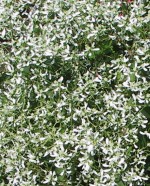 Diamond Frost (trade name for ‘Inneuphe’) looks so delicate that you would never know what a tough little plant it can be. From spring until fall it blooms without a pause even through the heat and humidity of a North Carolina summer while the petunias and geraniums gave up. In one container it so overwhelmed the other plants that I cut it back to the ground; no problem, it came back without a hint of hurt feelings or lack of vigor. It not only looks good in containers where it cascades over the sides but also makes a striking hanging baskets, nicely fills holes in borders as other plants fade, and can be moved indoors as a houseplant in winter. Used in a miniature flower arrangement as a filler like baby’s breath, it has a long vase life and lasts longer than most other flowers. Don’t be surprised if the stems form roots in the water (yes, they can be potted up in about a week when the roots are an inch or more long, and then planted in the garden). It is heat and drought tolerant, and deer avoid it probably because of its sap. Like poinsettias (it is in the same family), its cut stems exude a thick latex sap that can cause skin irritation to those who are allergic.
Diamond Frost (trade name for ‘Inneuphe’) looks so delicate that you would never know what a tough little plant it can be. From spring until fall it blooms without a pause even through the heat and humidity of a North Carolina summer while the petunias and geraniums gave up. In one container it so overwhelmed the other plants that I cut it back to the ground; no problem, it came back without a hint of hurt feelings or lack of vigor. It not only looks good in containers where it cascades over the sides but also makes a striking hanging baskets, nicely fills holes in borders as other plants fade, and can be moved indoors as a houseplant in winter. Used in a miniature flower arrangement as a filler like baby’s breath, it has a long vase life and lasts longer than most other flowers. Don’t be surprised if the stems form roots in the water (yes, they can be potted up in about a week when the roots are an inch or more long, and then planted in the garden). It is heat and drought tolerant, and deer avoid it probably because of its sap. Like poinsettias (it is in the same family), its cut stems exude a thick latex sap that can cause skin irritation to those who are allergic.
Type: Tender perennial usually grown as an annual
Bloom: Structures that appear to be flowers are actually white bracts; they cover the plant from spring until fall.
Foliage: Small gray-green leaves.
Size: 12-18”H x 8-12” W
Light: Full sun to part shade.
Soil: Moderately fertile, well-drained.
Fertilizer: Apply complete fertilizer in spring to beds; complete slow release fertilizer in spring to pots.
Hardiness: Zones 10-12
Care: Low maintenance
Pests and Diseases: None of importance under good growing conditions but rot can be a problem in poorly drained soils. Susceptible to aphids, spider mites, and mealy bugs.
Propagation: Seeds are not available but plant may self seed; division; cuttings.
Companion plants: Geranium, petunia, impatients; good cascading plant for containers.
